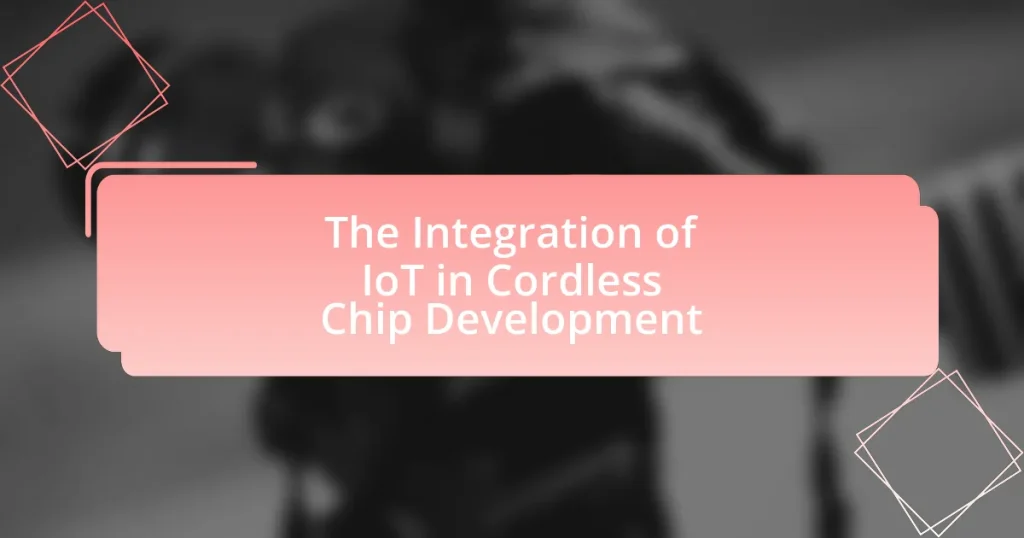The integration of the Internet of Things (IoT) in cordless chip development involves embedding connectivity features into chips, enabling devices to communicate and exchange data over the internet. This advancement enhances the functionality of cordless devices, facilitating applications such as smart home automation and remote monitoring. Key IoT technologies, including Low Power Wide Area Network (LPWAN) protocols, Bluetooth Low Energy (BLE), and Zigbee, improve performance and energy efficiency while addressing challenges related to power consumption, security, and interoperability. The article explores the significance of IoT integration for manufacturers and end-users, the technical hurdles faced, and future trends shaping the cordless chip market.

What is the Integration of IoT in Cordless Chip Development?
The integration of IoT in cordless chip development involves embedding connectivity features into chips that enable devices to communicate and exchange data over the internet. This integration enhances the functionality of cordless devices, allowing for remote monitoring, control, and automation. For instance, IoT-enabled cordless chips can facilitate smart home applications, where devices like cordless vacuum cleaners or smart speakers can be controlled via mobile apps or voice commands. The market for IoT in consumer electronics is projected to grow significantly, with estimates suggesting that the number of connected devices will reach over 75 billion by 2025, underscoring the importance of integrating IoT capabilities in cordless chip technology.
How does IoT enhance cordless chip functionality?
IoT enhances cordless chip functionality by enabling real-time data exchange and remote control capabilities. This integration allows cordless chips to communicate with other devices and systems, facilitating improved performance, energy efficiency, and user experience. For instance, IoT-enabled cordless chips can adjust their operations based on real-time environmental data, optimizing battery usage and extending device lifespan. Additionally, the ability to receive software updates over the air ensures that these chips can adapt to new functionalities and security protocols, thereby maintaining their relevance and effectiveness in a rapidly evolving technological landscape.
What specific IoT technologies are utilized in cordless chip development?
Specific IoT technologies utilized in cordless chip development include Low Power Wide Area Network (LPWAN) protocols, Bluetooth Low Energy (BLE), and Zigbee. LPWAN protocols, such as LoRaWAN, enable long-range communication with minimal power consumption, making them ideal for battery-operated devices. Bluetooth Low Energy facilitates short-range connectivity, allowing for efficient data transfer between devices while conserving energy. Zigbee provides a robust mesh networking capability, enhancing communication reliability among multiple devices in a network. These technologies collectively support the development of efficient, scalable, and interconnected cordless chip solutions.
How do these technologies improve performance and efficiency?
The integration of IoT in cordless chip development improves performance and efficiency by enabling real-time data collection and analysis. This allows for optimized resource management, reduced energy consumption, and enhanced operational capabilities. For instance, IoT-enabled chips can monitor their own performance metrics, leading to adaptive adjustments that enhance processing speeds and minimize latency. Additionally, studies show that IoT applications in chip development can lead to a 30% increase in energy efficiency by utilizing smart algorithms for power management.
Why is the integration of IoT important for cordless chips?
The integration of IoT is crucial for cordless chips because it enhances their functionality and connectivity. Cordless chips equipped with IoT capabilities can communicate with other devices and systems, enabling real-time data exchange and remote monitoring. This integration allows for improved energy efficiency, as IoT-enabled chips can optimize power consumption based on usage patterns. Additionally, according to a report by MarketsandMarkets, the IoT market is projected to grow to $1.1 trillion by 2026, indicating a significant demand for connected devices, which cordless chips can fulfill. Thus, the integration of IoT not only increases the utility of cordless chips but also aligns with market trends towards smarter, interconnected technology.
What advantages does IoT integration provide to manufacturers?
IoT integration provides manufacturers with enhanced operational efficiency and real-time data analytics. By connecting devices and machinery, manufacturers can monitor performance, predict maintenance needs, and optimize production processes. For instance, a study by McKinsey & Company found that IoT can reduce operational costs by up to 30% through improved asset utilization and reduced downtime. This integration allows for better decision-making based on accurate, real-time information, ultimately leading to increased productivity and reduced waste.
How does IoT integration impact end-user experience?
IoT integration significantly enhances end-user experience by providing seamless connectivity and real-time data access. This connectivity allows users to interact with devices more intuitively, leading to increased convenience and efficiency in daily tasks. For instance, a study by McKinsey & Company found that IoT applications can improve user satisfaction by up to 30% through personalized services and automation. Additionally, real-time monitoring and control of devices empower users to make informed decisions, further enriching their experience.

What are the challenges in integrating IoT with cordless chip development?
Integrating IoT with cordless chip development faces several challenges, primarily related to power consumption, security, and interoperability. Power consumption is critical because IoT devices often rely on battery life, necessitating efficient chip designs that minimize energy use while maintaining performance. Security is another significant challenge, as the increased connectivity of IoT devices exposes them to potential cyber threats, requiring robust encryption and secure communication protocols. Interoperability issues arise from the diverse range of standards and protocols used in IoT, making it difficult for different devices and systems to communicate effectively. These challenges highlight the complexity of developing cordless chips that can seamlessly integrate into the IoT ecosystem while ensuring reliability and security.
What technical hurdles must be overcome?
The technical hurdles that must be overcome in the integration of IoT in cordless chip development include power management, data security, and interoperability. Power management is critical because IoT devices often rely on battery power, necessitating efficient energy consumption to prolong device life. Data security is essential to protect sensitive information transmitted over networks, as IoT devices are vulnerable to cyberattacks; for instance, a 2021 report indicated that 70% of IoT devices have security vulnerabilities. Interoperability challenges arise from the need for different devices and platforms to communicate effectively, which requires standardized protocols and compatibility across various systems. Addressing these hurdles is vital for the successful deployment of IoT-enabled cordless chips.
How do security concerns affect IoT integration in cordless chips?
Security concerns significantly hinder IoT integration in cordless chips by necessitating robust encryption and authentication measures. These measures increase the complexity and cost of development, as manufacturers must implement advanced security protocols to protect against vulnerabilities such as unauthorized access and data breaches. For instance, a report by the Internet of Things Security Foundation highlights that 70% of IoT devices are susceptible to attacks due to inadequate security features, which directly impacts the adoption and trust in cordless chip technologies. Consequently, the need for enhanced security can delay product launches and limit the scalability of IoT solutions in the cordless chip market.
What are the limitations of current technology in this integration?
Current technology in the integration of IoT in cordless chip development faces several limitations, including power consumption, data security, and interoperability. Power consumption remains a critical challenge, as many IoT devices require efficient energy management to prolong battery life, which is often not achieved with existing chip designs. Data security is another significant limitation, as the increasing number of connected devices raises vulnerabilities to cyberattacks, with a report from Cybersecurity Ventures predicting that cybercrime will cost the world $10.5 trillion annually by 2025. Interoperability issues arise due to the lack of standardized protocols, making it difficult for devices from different manufacturers to communicate effectively, which hinders the seamless integration of IoT systems.
How can these challenges be addressed?
To address the challenges in the integration of IoT in cordless chip development, manufacturers can adopt a multi-faceted approach that includes enhancing collaboration between hardware and software teams, investing in robust security protocols, and utilizing advanced manufacturing techniques. Enhanced collaboration ensures that both hardware and software components are designed to work seamlessly together, reducing compatibility issues. Investing in robust security protocols is crucial, as IoT devices are often vulnerable to cyber threats; for instance, a report by McKinsey highlights that 60% of IoT devices lack adequate security measures. Advanced manufacturing techniques, such as 3D printing and automated assembly, can improve production efficiency and reduce costs, as evidenced by a study from Deloitte, which found that companies using these techniques saw a 30% reduction in production time.
What best practices can be implemented for successful integration?
Successful integration of IoT in cordless chip development can be achieved through several best practices. First, establishing clear communication protocols among devices ensures seamless data exchange and interoperability. For instance, using standardized communication frameworks like MQTT or CoAP can enhance compatibility across various IoT devices.
Second, implementing robust security measures is crucial to protect data integrity and user privacy. According to a report by McKinsey, 60% of IoT security breaches stem from inadequate security practices, highlighting the need for encryption and secure authentication methods.
Third, conducting thorough testing and validation of the integrated system helps identify potential issues early in the development process. Research from IEEE indicates that early-stage testing can reduce integration costs by up to 30%.
Lastly, fostering collaboration among cross-functional teams, including hardware engineers, software developers, and data analysts, promotes a holistic approach to integration, ensuring that all aspects of the system are aligned and optimized for performance.
How can collaboration between industries facilitate solutions?
Collaboration between industries can facilitate solutions by leveraging diverse expertise and resources to drive innovation and efficiency. For instance, in the integration of IoT in cordless chip development, partnerships between semiconductor manufacturers and software developers can lead to the creation of more efficient, interconnected devices. This collaboration enables the sharing of knowledge regarding hardware capabilities and software requirements, resulting in optimized performance and reduced time-to-market. A study by McKinsey & Company highlights that cross-industry collaborations can increase innovation rates by up to 30%, demonstrating the tangible benefits of such partnerships in developing advanced technologies.

What are the future trends in IoT and cordless chip development?
Future trends in IoT and cordless chip development include increased integration of artificial intelligence, enhanced energy efficiency, and the expansion of 5G connectivity. The integration of AI allows for smarter devices that can process data locally, reducing latency and bandwidth usage. Enhanced energy efficiency is driven by the demand for longer battery life in IoT devices, leading to the development of low-power chips that can operate effectively for extended periods. The expansion of 5G connectivity facilitates faster data transmission and supports a larger number of connected devices, which is crucial for the scalability of IoT applications. According to a report by MarketsandMarkets, the global IoT market is expected to grow from $250 billion in 2020 to over $1 trillion by 2025, highlighting the significant impact of these trends on the industry.
How is the market evolving with IoT advancements?
The market is evolving rapidly with IoT advancements, driven by increased connectivity and the proliferation of smart devices. As of 2023, the global IoT market is projected to reach $1.1 trillion, reflecting a compound annual growth rate (CAGR) of 25.4% from 2021 to 2028. This growth is fueled by innovations in wireless communication technologies, such as 5G, which enhance data transmission speeds and reduce latency, enabling more efficient device interactions. Additionally, the integration of IoT in cordless chip development is leading to smaller, more energy-efficient chips that support a wider range of applications, from smart homes to industrial automation. The demand for real-time data analytics and improved user experiences further accelerates market expansion, as businesses increasingly adopt IoT solutions to optimize operations and enhance customer engagement.
What emerging technologies are influencing cordless chip development?
Emerging technologies influencing cordless chip development include advanced semiconductor materials, artificial intelligence, and 5G connectivity. Advanced semiconductor materials, such as gallium nitride and silicon carbide, enable higher efficiency and performance in chip design. Artificial intelligence enhances the design process through machine learning algorithms that optimize chip architecture and power consumption. Additionally, 5G connectivity facilitates faster data transmission and improved communication capabilities for cordless devices, driving the demand for more sophisticated chip designs. These technologies collectively contribute to the evolution of cordless chips, making them more efficient and capable of supporting the growing Internet of Things ecosystem.
How will consumer demands shape future developments?
Consumer demands will significantly shape future developments in cordless chip technology by driving innovation towards enhanced connectivity, energy efficiency, and user-centric features. As consumers increasingly prioritize seamless integration of Internet of Things (IoT) devices, manufacturers will focus on developing chips that support faster data transfer rates and lower power consumption. For instance, the global IoT market is projected to reach $1.1 trillion by 2026, indicating a strong demand for advanced chip solutions that can handle the growing number of connected devices. This trend compels developers to create more sophisticated, compact, and efficient chips that meet consumer expectations for performance and sustainability.
What role will IoT play in the next generation of cordless chips?
IoT will significantly enhance the functionality and efficiency of the next generation of cordless chips by enabling seamless connectivity and real-time data exchange. This integration allows cordless chips to communicate with various devices and systems, facilitating smarter applications in areas such as home automation, healthcare, and industrial monitoring. For instance, according to a report by Statista, the number of connected IoT devices is projected to reach 30.9 billion by 2025, indicating a growing demand for chips that can support such connectivity. This trend underscores the necessity for cordless chips to incorporate IoT capabilities to remain competitive and meet evolving consumer needs.
How will IoT integration redefine product capabilities?
IoT integration will redefine product capabilities by enabling real-time data collection and analysis, which enhances functionality and user experience. This integration allows products to communicate with each other and with users, leading to smarter decision-making and automation. For instance, in cordless chip development, IoT-enabled devices can monitor performance metrics and optimize energy consumption, resulting in longer battery life and improved efficiency. According to a report by McKinsey, IoT applications can increase productivity by up to 30% in various sectors, demonstrating the significant impact of IoT on product capabilities.
What potential innovations can we expect in the near future?
We can expect significant innovations in the integration of IoT in cordless chip development, particularly advancements in energy efficiency and connectivity. These innovations will likely include the development of ultra-low-power chips that can operate for extended periods without battery replacement, driven by improvements in energy harvesting technologies. For instance, research from the IEEE indicates that new materials and designs can reduce power consumption by up to 90%, enabling longer-lasting devices. Additionally, enhanced connectivity protocols, such as Bluetooth 5.0 and Wi-Fi 6, will facilitate faster data transmission and improved device interoperability, making it easier for various IoT devices to communicate seamlessly.
What are the best practices for integrating IoT in cordless chip development?
The best practices for integrating IoT in cordless chip development include ensuring robust security measures, optimizing power consumption, and implementing scalable architecture. Robust security is essential to protect data and devices from cyber threats, as evidenced by the increasing number of IoT-related security breaches, which reached over 1.5 billion in 2022. Optimizing power consumption is critical for extending battery life in cordless devices, with low-power protocols like Bluetooth Low Energy (BLE) and Zigbee being widely adopted. Implementing a scalable architecture allows for future upgrades and integration of additional features, which is vital as IoT ecosystems evolve rapidly. These practices collectively enhance the functionality, security, and longevity of cordless IoT devices.

